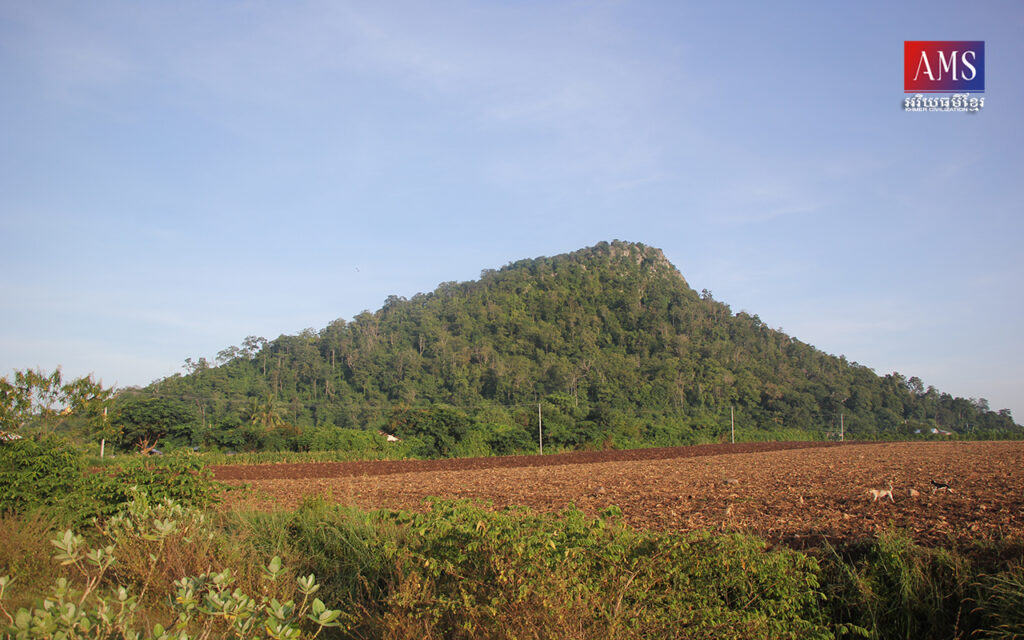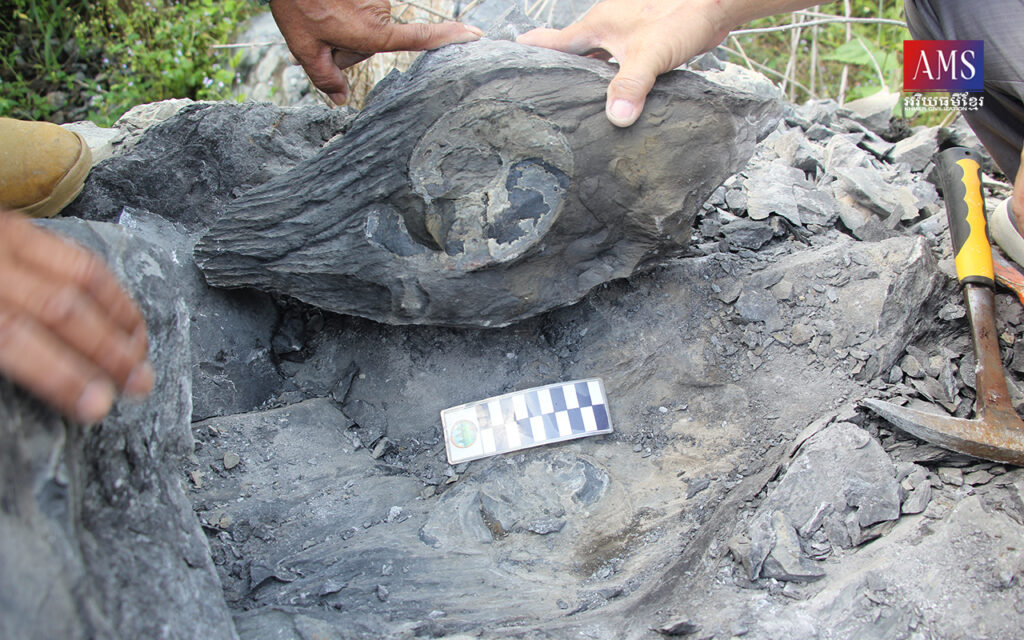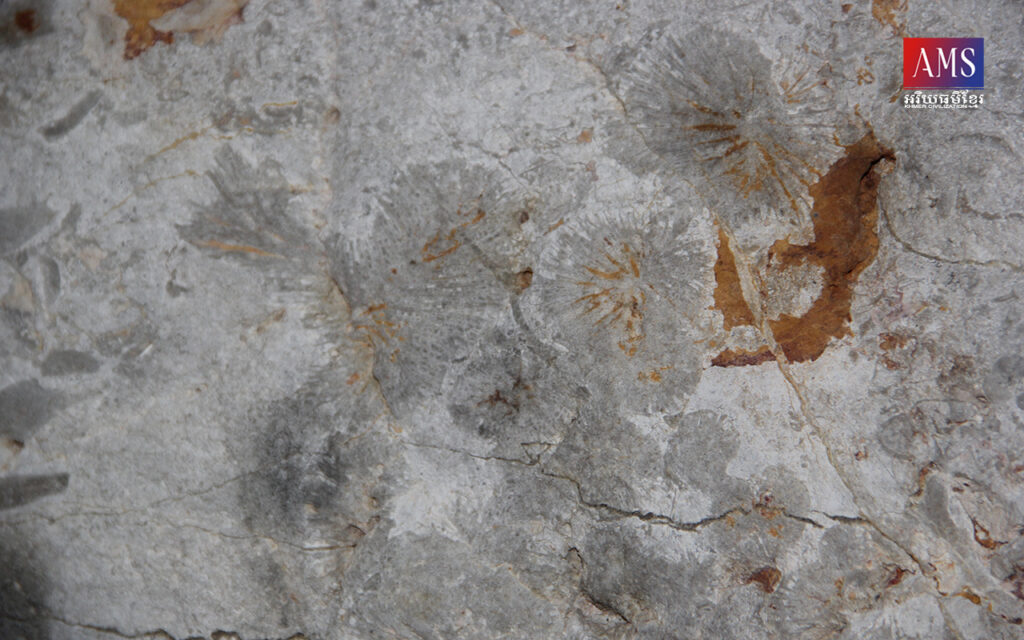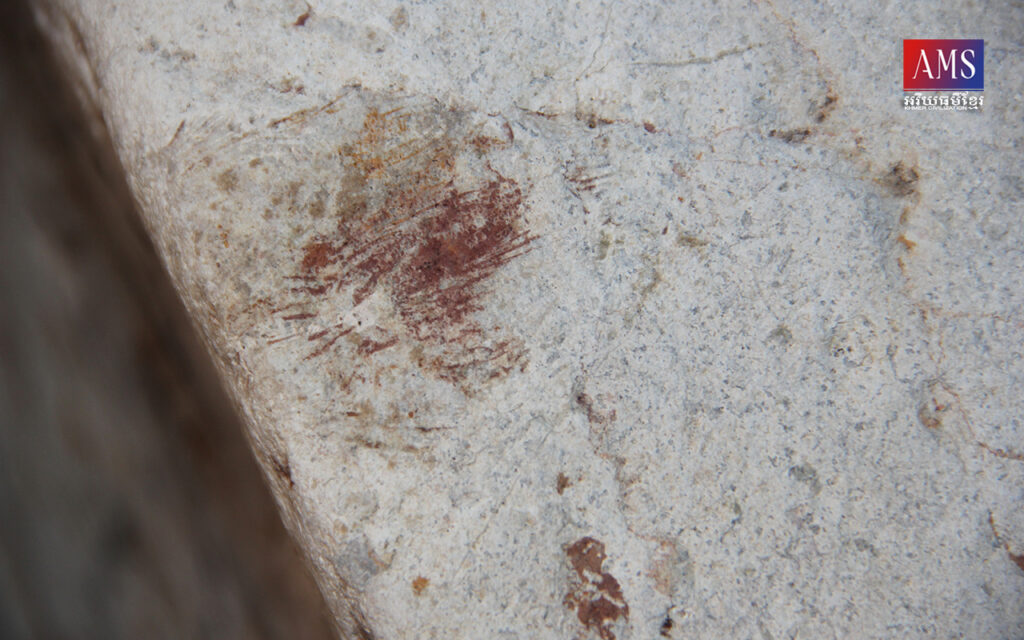ភ្នំប្រាំពីរជាស្ថានីយផូស៊ីលសត្វសមុទ្របុរាណមួយកន្លែង មានទីតាំងស្ថិតនៅឃុំបួរ ស្រុកភ្នំព្រឹក ខេត្តបាត់ដំបង។ ភ្នំនេះស្ថិតនៅតាមបណ្តោយផ្លូវជាតិលេខ៥៧B ស្ថិតនៅក្បែរទីប្រជុំជនមួយហៅថាផ្សារបួរ។ ភ្នំប្រាំពីរជាភ្នំថ្មកំបោរ ដែលបានកំណត់អាយុកាលក្នុងស័កទី១ Paleozoic សម័យ Permian (២៥១-២៩៩លានឆ្នាំ)។ ភ្នំប្រាំពីរត្រូវបានរាជរដ្ឋាភិបាលដាក់ចូលជាតំបន់បេតិកភណ្ឌធម្មជាតិ ដោយអនុក្រឹត្យលេខ៦៤អនក្រ.បក ចុះថ្ងៃ២៥ ខែឧសភា ឆ្នាំ២០២០ ដោយមានផ្ទៃដី៣៥៣,៩ហិចតា។ ភ្នំនេះមានរូងភ្នំជាច្រើន និងជាតំបន់ដែលមានសក្តានុពលសម្រាប់វិស្ស័យទេសចរណ៍ធម្មជាតិផងដែរ។
តាមរយៈការចុះសិក្សាស្រាវជ្រាវបឋមរបស់ក្រុមការងារផូស៊ីលនៃនាយកដ្ឋាន តំបន់បេតិកភណ្ឌ អគ្គសហកមន៍មូលដ្ឋាន ក្រសួងបរិស្ថាន កាលពីថ្ងៃទី០៨ ខែកញ្ញា ឆ្នាំ២០២០ និងបានបន្តចុះសិក្សាលើកទី២កាលពីខែវិច្ឆិកា ឆ្នាំ២០២១បានបង្ហាញថា ភ្នំនេះមានអតីតកាលជាសមុទ្រ ដែលកើតឡើងដោយកំណកនៃថ្មកំបោរ។ ថ្មកំបោរជាប្រភេទថ្មដែលកើតពីកំណកនៃជីវៈចម្រុះមួយចំនួន ដែលបានបង្កើតពីការប្រមូលផ្តុំនៃសំបកគ្រំ ងាវ, ផ្កាថ្ម, សារាយ, សំណល់ផ្សេងៗ និងកំទេចកំទីសរីរាង្គផ្សេងទៀត។ វាក៏អាចបង្កើតបានដោយដំណើរការនៃកំណកគីមីដូចជា ទឹកភ្លៀងនៃកាបូនកាល់ស្យូមពីទឹកបឹង ឬទឹកសមុទ្រ។ភ្នំប្រាំពីរ ជាស្ថានីយផូស៊ីលសត្វសមុទ្រមួយដែលមានលក្ខណៈខុសពីផូស៊ីលសត្វសមុទ្រនៅតំបន់មួយចំនួនក្នុងខេត្តបន្ទាយមានជ័យ ដូចជាភ្នំបាក់ ភ្នំស្វាយ និងភ្នំបន្ទាយនាងជាដើម។ ផូស៊ីលសត្វសមុទ្រដែលរកឃើញនៅភ្នំប្រាំពីរ ភាគច្រើនស្ថិតនៅក្នុងថ្មកំបោរត្រង់ចំនុចទីតាំងដែលត្រូវបានគេកាយយកថ្មពីកាលកន្លងទៅ។ ប្រភេទផូស៊ីលដែលយើងរកឃើញនៅភ្នំប្រាំពីររួមមាន៖
១. មានរូបរាងដូចខ្យងដែលមានអវៈយវៈដូចម៉ិក ជាប្រភេទពពួករស់នៅទឹកជ្រៅ ត្រូវបានរកឃើញនៅភ្នំប្រាំពីរ ក្នុងស្រទាប់ថ្មកំបោរ។ យើងមិនទាន់អាចកំណត់ឈ្មោះនៃប្រភេទនីមួយៗបាននៅឡើយទេ។ ហើយប្រភេទពពួកនេះ មានទំហំជិត២០ស.ម ស្ថិតនៅ Phylum Mollusca, Class Cephalopoda, Sup class Nautiloidea។
២. អាចជាពពួកអាម៉ូនីត ដែលមានរូបរាងដូចខ្យង មានអវៈយវៈដូចម៉ិក ជាប្រភេទរស់នៅក្នុងទឹកជ្រៅ។ សំបករបស់វាមានជាក្រឡាឆ្នូតៗ យើងបានរកឃើញពពួកនេះមានទំហំតូចជាង១០ស.ម។ ពួកវាស្ថិតនៅ Phylum Mollusca, Class Cephalopoda, Sup class Ammonoidea។
៣. ក៏មានលក្ខណៈប្រហាក់ប្រហែលនឹងរូបលេខ៦ ដែរ គ្រាន់តែវាអាចខុសឈ្មោះគ្នាតែប៉ុណ្ណោះ។ ពួកវាស្ថិតនៅ Phylum Mollusca, Class Cephalopoda, Sup class Ammonoidea។
៤. ផូស៊ីលមានលក្ខណៈជាស្នាកស្នាមដូចមុខកាត់នៃផ្កាថ្ម តែយើងមិនទាន់អាចកំណត់អត្តសញ្ញាណបាននៅលើយទេ។ យើងបានប្រទះឃើញផូស៊ីលប្រភេទនេះ ជាច្រើនដែលលេចឡើងនៅលើថ្មកំបោរ និងមាននៅជាប់ក្នុងរូងភ្នំផងដែរ។
៥. ពពួកផូស៊ីលម្យ៉ាងទៀតដែលមានស្នាកស្នាមដូចផូស៊ីលសត្វសមុទ្រដែរ ដែលមានទំហំប្រមាណ១០ស.ម។ យើងបានរកឃើញតែមួយដុំទេនៅក្នុងរូងភ្នំប្រាំពីរ ហើយក៏មិនទាន់អាចកំណត់អត្តសញ្ញាណបាននៅឡើយ។
៦. អាចជាផូស៊ីលមួយផងដែរ ដែលមានទំហំប្រមាណ១០ស.ម និងរកឃើញនៅក្នុងរូងភ្នំ ពពួកនេះអាចជាប្រភេទដែលរស់នៅក្នុងទឹកជ្រៅ។
៧. យើងបានជួប Brachiopod ដោយមានមួយចំនួន មានសំបករលោង មានលក្ខណៈប្រហាក់ប្រហែល និងសត្វកាឈីវនាពេលបច្ចុប្បន្ន។
៨. ផូស៊ីលពពួកលាស តែមិនដឹងថាមានឈ្មោះអ្វីនោះទេ។ ពួកនេះស្ថិតនៅក្នុង Phylum Mollusca, Class Bivalvia។
៩. ផូស៊ីលមួយចំនួនដែលបានរកឃើញ នៅផ្នែកខ្លះនៃភ្នំ យើងបានរកឃើញនៅក្នុងស្រទាប់ដីឥដ្ឋដែលក្នុងពេលនោះប្រហែលជាមានជម្រៅរាក់ដូចជាប្រភេទមួយក្នុងក្រុមលាស ស្នាមឆ្នូតៗដូចសំបកសែល ស្ថិតនៅក្នង Phylum Mollusca, Class Bivalvia, Subclass Pterimorphia, Oder Arcida, Family Glycymerididae។
១០. ផូស៊ីលជាពពួក គ្រំ ដែលយើងមិនទាន់ស្គាល់ឈ្មោះវានៅឡើយ។ ដែលស្ថិតនៅ Phylum Mollusca, Class Bivalvia, Subclass Palaeoheterodonta ដែលមានលក្ខណៈប្រហាក់ប្រហែល។
១១. ផូស៊ីលអាចជាប្រភេទពពួក Phylum Porifera (Sponges) ដែលពួកនេះមានលក្ខណៈប្រហាក់ប្រហែលផ្កាថ្ម តែវាស្ពោត ទន់ៗដូចអេប៉ុង។
រួមសេចក្តីមកយើងអាចនិយាយបានថា ភ្នំប្រាំពីរ ជាទីតាំងផូស៊ីលសត្វសមុទ្រមួយ ដែលអាយុកាលក្នុងស័កទី១ Paleozoic ក្នុងសម័យ Permian (២៥១-២៩៩លានឆ្នាំ)។ ទីតាំងនេះជាទីតាំងដែលគួរចាប់អារម្មណ៍ សម្រាប់ការសិក្សាស្រាវជ្រាវនាពេលអនាគត។ នៅពេលដែលយើងអាចមានលទ្ធភាពសហការណ៍ជាមួយអ្នកជំនាញអន្តរជាតិ ដើម្បីបកស្រាយនៅចម្ងល់ទាំងឡាយដែលមាន។ ក្នុងនោះដែរក្រុមការងារនឹងបន្តការសិក្សាស្រាវជ្រាវជាបន្តនៅឆ្នាំបន្តបន្ទាប់ទៀត៕
—————————————————————–
Phnom Pram Pi Marine Fossil Site
Phnom Pram Pi is an ancient marine fossil site located in Buor commune, Phnom Preuk district, Battambang province. Along National Road 57B, near a town called Phsar Buor. Phnom Prampi is a limestone mountain with an age in the first Paleozoic era of the Permian period (251-299 million years). Phnom Prampi has been designated as a Natural Heritage Site by the Royal Government by Sub-Decree No. 64, dated May 25, 2020, with an area of 353.9 hectares. This mountain has many caves and is also a potential for eco-tourism.
Limestone is a type of rock formed by the accumulation of a number of biodiversities, formed from the accumulation of shells, corals, algae, and other wastes and organic debris. It can also be formed by the process of chemical precipitation, such as the precipitation of calcium carbonate from lakes or seawater. From fossils of marine animals in some areas in Banteay Meanchey province, such as Phnom Bak, Phnom Svay, and Phnom Banteay Neang, etc. Most of the marine fossils found in the Phnom Pram Pi were in limestone at the site of the excavation. Rocks of the past. Those types of fossils include are:
1. A snail-like shape with octopus-like limbs, a type of deep-water species found in the limestone layer. We have not yet been able to determine the name of each species, and these species are nearly 20 cm in size and were at the class Phylum Mollusca, Class Cephalopoda, and Sup class Nautiloidea.
2. Can be an Ammonite species that is snail-shaped with Octopus-like limbs, a species that lives in deep water. There are stripes on its shell, we found these are smaller than 10 cm. They were in Class Phylum Mollusca, Class Cephalopoda, and Sup class Ammonoidea.
3. They are also similar to ammonite species that is snail-shaped with Octopus-like limbs, but they just may have different names. These species were Phylum Mollusca, Class Cephalopoda, and Sup class Ammonoidea.
4. This Fossils characteristic are similarly of corals, but we have not yet been able to identify them. We have seen many of these fossils that appear on limestone and even in caves.
5. Another type of fossil that has the same scars as the marine fossils are about 10 cm in size. We found only one piece in the Phnom Pram Pi caves and have not yet been identified.
6. it can also be a fossil about 10 cm in size and found in caves, this species can be species that lives in deep water.
7. We also found Brachiopods, some of which have smooth shells and they are similar to Brachiopod today.
8. The lamp shall Fossils but do not know their names. They are in Phylum Mollusca, Class Bivalvia.
9. Some fossils found in parts of the mountains we found in the clay layer, which at that time about Shallow depth, like a species in the lamp shell-like in Phylum Mollusca, Class Bivalvia, Subclass Pterimorphia, Oder Arcida, Family Glycymerididae.
10. Mussel Fossils species that we do not yet know their names, and were in Phylum Mollusca, Class Bivalvia, Subclass Palaeoheterodonta.
11. Fossils can be Phylum Porifera (Sponges), which look like corals.
In short, we can say that the Phnom Pram Pi is a site of marine fossils dating back to the First Paleozoic era in the Permian period (251-299 million years). This site is an interesting place for future research, if we have any cooperation with international experts to answer any questions that may arise. Furthermore, this site will be continued to research in the next year.
អត្ថបទដើម៖ លោក លឹម វណ្ណច័ន្ទ















